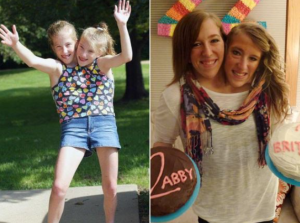
They Were Born With One Body and a Death Sentence, but They Chose to Live
When Abigail and Brittany Hensel were born on March 7, 1990, in Carver County, Minnesota, doctors, nurses, and family members were in shock. Conjoined twins are already rare—estimated at about 1 in 200,000 live births—but Abby and Brittany’s case was even more extraordinary. They were dicephalic parapagus twins, meaning they shared one body but had two heads, two hearts, and separate spinal cords. From the very beginning, the odds seemed stacked against them. Medical professionals predicted a short life filled with complications. Yet against all expectations, the twins chose not only to survive, but to embrace life with remarkable courage, determination, and joy.
From infancy, the Hensel twins captured the public’s imagination. Their early survival defied medical predictions. Most dicephalic twins die shortly after birth due to the immense physical challenges of sharing vital organs and systems. But Abby and Brittany’s bodies developed in a way that gave them a unique advantage. While they shared most of their lower body—one torso, one set of arms (with a surgically removed third arm at infancy), and legs—they had two hearts, two stomachs, two sets of lungs, and separate spinal columns. Their nervous systems met at the pelvis. Each twin controls one side of their body: Abby controls the right arm and leg, Brittany controls the left. Every movement—whether walking, running, or driving—requires constant, wordless cooperation between them.
As babies and toddlers, their parents, Patty and Mike, made a key decision that would define the twins’ lives: they would not focus on limitations but on possibilities. From an early age, Abby and Brittany were encouraged to live as normally as possible. They learned to crawl, walk, ride bikes, and even swim. These milestones took enormous effort and coordination, but the girls faced every challenge with determination and humor.
Growing up in a small town, Abby and Brittany had a supportive community that treated them as individuals, not as medical curiosities. But that didn’t mean their path was easy. Every public outing meant stares, whispers, and questions. Yet the twins developed an inner resilience, often joking about their situation and showing remarkable poise in interviews and documentaries. “We’re just normal people,” they have said repeatedly, and indeed, they have lived normal lives in many ways—going to school, playing sports, hanging out with friends, and dreaming about the future.
Their academic success was another triumph. The twins graduated from high school and went on to earn a teaching degree from Bethel University in St. Paul, Minnesota. Both had a passion for education and wanted to inspire children the way their own teachers had inspired them. Their unique dynamic—two minds working together in one classroom—brought a special energy to their teaching style. Today, they work as elementary school teachers, focusing on math. They are beloved by their students, who quickly see beyond the physical differences and respond to the twins’ warmth, patience, and creativity.
Medically, the twins have faced complications, as expected. They’ve undergone several surgeries to correct scoliosis, expand their chest cavity, and address other challenges. Yet through it all, their outlook has been remarkably positive. They’ve always insisted they wouldn’t want to be separated, even if it were technically possible—a procedure that would be dangerous and almost certainly fatal for one or both of them. Their connection, both physical and emotional, is profound. They don’t just share a body—they share a life, dreams, and decisions.
Adulthood brought new challenges, especially when it came to questions of independence, privacy, and relationships. Abby and Brittany have expressed a desire for families of their own one day, although they’ve kept most details about their personal relationships private. They’ve also navigated issues of identity with grace. While they share a body, they are very much two individuals, with distinct personalities, preferences, and opinions. Abby tends to be more outspoken and assertive, while Brittany is more easygoing. They compromise and adapt, showing the kind of teamwork that most people can only aspire to.
Their story has been shared through documentaries, TV specials, and their own short-lived reality series, Abby & Brittany. These programs offered a glimpse into their daily lives, but the twins have always been careful to set boundaries, determined not to let media attention define who they are. They want to be seen as educators, daughters, sisters, and friends—not simply as medical anomalies.
What makes Abby and Brittany’s story so compelling is not just their survival, but their choice to thrive. They could have led a life hidden from view, defined by fear or pity. Instead, they chose to embrace life with courage, humor, and strength. Their very existence challenges society’s ideas about normalcy, ability, and identity. They show that life’s value isn’t measured by how closely we fit the standard mold, but by how we face our challenges, how we love, and how we contribute to the world.
Looking at Abby and Brittany, one is reminded of the resilience of the human spirit. They were given a body that many saw as a death sentence. But they transformed it into a vehicle for living fully, for teaching others, and for proving that limitations are often in the eye of the beholder. Their journey continues—one step at a time, one day at a time, always together.
Their story is not just about conjoined twins—it’s about the power of determination, the importance of support systems, and the beauty of choosing to live, no matter the odds.
